Office buildings won't "save" Anacostia
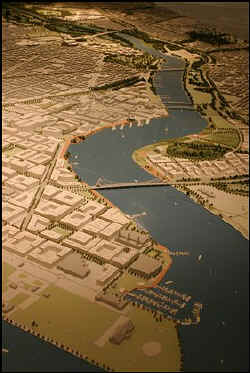 Anacostia district, Washington, DC. Image from Arkitera.
Anacostia district, Washington, DC. Image from Arkitera.Today's newspapers have articles about Mayor Williams suggestion to WMATA that they move their headquarters to the Anacostia Metro Station, to jumpstart development there. This article from the Post, "Williams Proposes Moving Metro Offices to Anacostia," is typical of the reports.
I have been pointing out in emails to Post writers and editors for 3-4 years that this kind of "economic development," doesn't have much in the way of "legs."
This isn't much different than proposals to move the DMV up Georgia Avenue, and DOES to the Minnesota Avenue Metro Station (now CSOSA will be going there).
Generally, I say the same thing over and over again--that this increases traffic and doesn't do much in the way of spillover economic development. My joke is that the only subsequent development spurred by the two partially HUD-funded office buildings on H Street's 600 block south side has been 1-2 hot dog carts Monday through Friday.
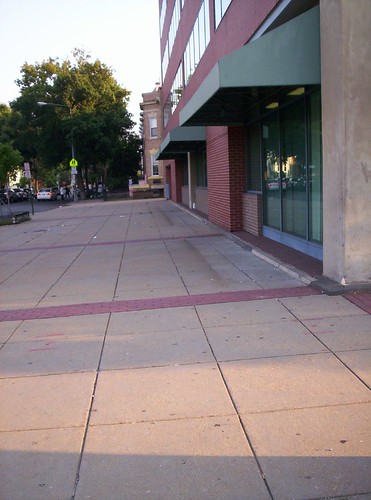 SE corner of the DHS office building on H Street. Imagine if this space was released to a restaurant like Sizzling Express, and the kind of street vitality that would be adding by beginning to mix the uses on this site.
SE corner of the DHS office building on H Street. Imagine if this space was released to a restaurant like Sizzling Express, and the kind of street vitality that would be adding by beginning to mix the uses on this site.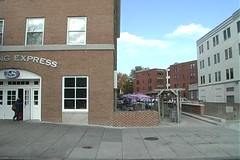 Sizzling Express exterior. Note the sideyard patio. The exterior photo, from Amazon, doesn't do the place justice. The interior is always hopping. I bet they average a minimum of 125 customers/hour.
Sizzling Express exterior. Note the sideyard patio. The exterior photo, from Amazon, doesn't do the place justice. The interior is always hopping. I bet they average a minimum of 125 customers/hour.Now I know the reason. Real estate research states that the average office worker supports 2 sq. feet of retail and 5 sq. feet of restaurant space. That means that 1,100 workers from WMATA would support 2,200 s.f. of retail and 5,500 s.f. of restaurant space. This totals about 1 retail store and 1.5 restaurants.
I wrote about this in the blog entry "Falling up -- Accountability and DC Community Development Corporations," in mid-July, which included a big section discussing another office building coming to Anacostia, discussed in the Post article, "Rising Anacostia Project Seen as Catalyst: Development Will Follow, Officials Say."
Retail is driven by density true, but street-based retail is driven by things to do on the street.
Yesterday's blog entry "What would Jane Jacobs Say?" quoted one of her great summations:
“People love activity, not emptiness.”
Office buildings, particularly the way they are designed today, suck the life out of the street, because they are big and usually only have one entrance, which diverts pedestrian traffic into particular forms usually unsupportive of street vitality. Compare this with 7th Street NW, which has storefronts every 40 feet or so.
[Note: have you noticed that the restaurant in MCI Center is now in its third or fourth iteration--it's not working! and it's not working because it's not in a good pedestrian location, the MCI Center isn't designed to strengthen street life, etc.]
Speaking of Jane Jacobs, Death and Life of the Great American City says that successful cities have four elements: people and building density; mixed primary uses; small blocks (this has to do with pedestrian movement and street life and activity); and a large stock of old buildings (capable of supporting innovation in retail and business development and independently-owned businesses).
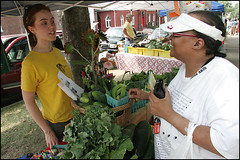 Anacostia Farmers Market photo from today's Washington Post. Photo by James M. Thresher.
Anacostia Farmers Market photo from today's Washington Post. Photo by James M. Thresher.I think that most everyone understands that "urban renewal" didn't work. So why do most city economic development proposals look like urban renewal, in programs and projects not even gussied up for the 21st century?
I'll admit I haven't paid as much attention to the Anacostia revitalization issue as perhaps I should. So I don't know much, but if you look at the "Neighborhood and Revitalization Plans" section of the DC Office of Planning Website for Ward 8 -- there isn't a comprehensive revitalization plan for Greater Anacostia.
 Anacostia rowhouses. DCPL photo. Both the DC Preservation League and the National Trust for Historic Preservation (I think) have listed the Anacostia Historic District as an endangered place.
Anacostia rowhouses. DCPL photo. Both the DC Preservation League and the National Trust for Historic Preservation (I think) have listed the Anacostia Historic District as an endangered place.I don't think you can argue that the Anacostia Waterfront Initiative should be relied upon as the revitalization plan for all of Anacostia, in particular the historic district and the retail-commercial district along Martin Luther King, Jr. Avenue.
The H Street Strategic Development Plan is a decent model. It's not perfect as it doesn't have action planning and implementation steps. But it is a vision. But it has gaps as it doesn't really focus on the anything other than the commercial district. As various planning initiatives come along, it's clear that a broader framework is necessary. I don't think that the Strategic Neighborhood Action Plans were all that strategic. They certainly didn't come up with meta-approaches and principles for addressing change, development, and improvement.
Anyway, I read planning documents for fun(?) and I would recommend the following plans and studies as useful examples to consider when thinking about the assets and opportunities of Greater Anacostia beyond the waterfront:
1. Historic Aycock Strategic Neighborhood Plan and in particular the "Charrette Book." (Greensboro, NC)
2. Hyattsville, Maryland Community Legacy Revitalization Plan (nice section on implementation steps)
3. Anacostia Heritage Trails Area (Maryland Cultural Heritage Tourism Plan). This is a great example of a cultural heritage and tourism plan.
4. The Soweto Retail Strategy and article "City to fuel economic development activity in Soweto" (Johannesburg, South Africa)
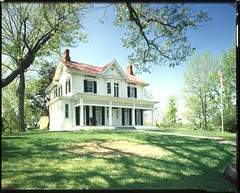 The Frederick Douglass House, pictured here, in a photo from the Library of Congress, and the Anacostia Museum, are two of the many cultural assets in the Greater Anacostia community, not to mention the views from the many high points of ground.
The Frederick Douglass House, pictured here, in a photo from the Library of Congress, and the Anacostia Museum, are two of the many cultural assets in the Greater Anacostia community, not to mention the views from the many high points of ground.There are other examples, including many closer to home, but these examples stick out in particular. So do three presentations made during the U Street planning process last year, presentations on the 18th and Vine Street District in Kansas City, the Upper Manhattan Empowerment Zone's focus on strengthening and extension of the cultural assets in the community as the foundation of revitalization, and DC's own Kathy Smith, ex-director of CulturalTourismDC, and her presentation on their project in the Shaw/U Street area. (These presentations can probably be obtained by sending email to Kevin Brady at the DCOP.)
Frankly, the root of Anacostia's commercial district revitalization lies in strengthening its cultural heritage in all aspects. That's why the Anacostia Trail Heritage Area example from Maryland is particularly relevant.
Also, the Crandall-Arambula one pager series of papers on steps to successful revitalization planning and implementation are good primers for understanding how the revitalization planning process ought to work.
I am certain that some of this work has already been done, including what I expect is a great overview of the cultural resources in Greater Anacostia in the book Capital Assets by Kathy Smith, and available from CulturalTourismDC. Also, there is the book, lamentably out-of-print, but available at the MLK Branch of the DC Public Library, called Anacostia Conserved which is about historic preservation as it relates to Anacostia. Published in 1979, it was produced in part by the late Kevin Lynch, one of the greats in understanding the elements of successful cities.
The Fort Circle Parks report from NPS has some good discussion of cultural resources in the Anacostia area (part 1; part 2). Then there is the Streetcar-Light Rail initiative--although as my blog entry from May "Whither Light Rail in Anacostia?" discussed, for whatever reasons, Anacostia residents don't seem much convinced that having better transit connections and options would be too helpful(???!!!).
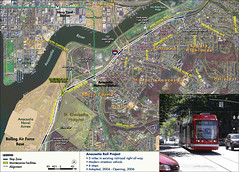 Anacostia Light Rail Map from the DC Transit Future website.
Anacostia Light Rail Map from the DC Transit Future website.There are plenty of opportunities. But mixed-use principles, including vertical mixed-use projects, are essential.
Note that one of the worst things from an "economic development" standpoint is a relatively new church, with a big parking lot, right next to the Anacostia Metro station--probably built on land acquired from the city. How many hours/week does this generate pedestrian vitality?
Really now, how much vitality exists on the streets of downtown after evening rush hour?
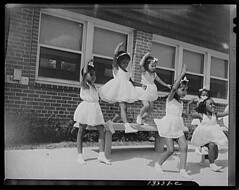 Anacostia, D.C. Frederick Douglass housing project. A dance group. Photo by Gordon Parks, available via the Library of Congress FSA Photo archives. Circa late 1930s.
Anacostia, D.C. Frederick Douglass housing project. A dance group. Photo by Gordon Parks, available via the Library of Congress FSA Photo archives. Circa late 1930s.



0 Comments:
Post a Comment
<< Home